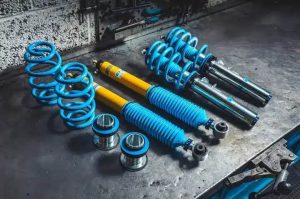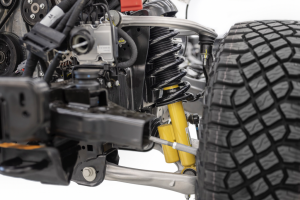A vehicle’s suspension system is more than just wheels and shocks — it’s a carefully tuned trio: springs, shock absorbers, and often struts. These components work in harmony to ensure ride comfort, road-holding, and safety. In this article, we’ll explore how suspension springs interact with shocks and struts, why this synergy is critical, and what to consider when upgrading or repairing.
Why the Trio Exists: Springs, Shocks, and Struts

-
Springs (coil or leaf) support the vehicle’s weight, absorb terrain irregularities, and work to keep tires on the road.
-
Shock absorbers control the energy stored by springs, damping motion to prevent bouncing.
-
Struts combine both functions in one unit and are common in MacPherson-suspension setups.
Together, they form a complementary system:
-
Springs store and release kinetic energy.
-
Shocks/struts absorb excess energy to stabilize motion.
-
The interaction between them dictates handling, comfort, and stability.
How Springs Complement Shocks and Struts
1. Energy Storage vs. Energy Dissipation
-
Springs compress under load and store potential energy — imagine a pogo stick.
-
Without dampers, that energy is released in uncontrolled oscillations — i.e., bounce.
-
Shocks (or struts with damping) provide resistance that transforms that energy into heat, stabilizing the car quickly after each bump.
2. Spring Rate Matters
Spring stiffness (rate) determines how much load is needed for a given compression.
| Spring Rate | Effect on Ride | Effect on Damping Requirements |
|---|---|---|
| Soft | Comfort-first, more travel | Needs stronger damping to prevent overshoot |
| Stiff | Responsive handling, less travel | Requires less damping force, but less forgiving |
Matching spring rate to shock valving (damping curve) is essential:
-
Over-damped: car feels harsh and unsettled.
-
Under-damped: car oscillates and feels slow to respond.
3. Strut Integration
Struts contain the shock absorber and structural element (spring perch).
-
They simplify assembly but demand precise tuning of spring and damper together.
-
Changing just the spring without adjusting the strut’s damping can throw off balance.
Types of Springs and Their Interaction
Coil Springs
-
Most common on modern cars and SUVs.
-
Work with shocks/struts in MacPherson or double-wishbone layouts.
Leaf Springs
-
Found in trucks and heavy-duty vehicles.
-
Work with shock absorbers mounted separately.
-
Handle higher loads, often paired with gas or twin-tube shocks.
Torsion Bars / Air Springs
-
Torsion bars act like long coils, twisting under load.
-
Air springs use pressurized airbags with shocks.
-
Both require damping adjusted to their spring characteristics.
Common Spring and Shock Pairing Configurations
-
Stock Setup
-
Manufacturer-matched spring rates and damper valving.
-
Balanced ride comfort and handling.
-
-
Lowering Springs + Stock Shocks
-
Firmer ride, better turn-in — but stock shocks may overreact.
-
Re-valving or replacing shocks improves control.
-
-
Lift Kits + Heavy-Duty Shocks
-
More travel and ground clearance.
-
Require stiffer springs and stronger shocks to prevent bottoming.
-
-
Performance Springs + Adjustable Shocks
-
Tuned for track or spirited driving.
-
Adjustable damping allows fine control over handling and ride quality.
-
Tips for Perfect Suspension Matching
-
Match spring rate to vehicle use (comfort, off-road, performance).
-
Choose shocks/struts designed for that spring rate — check manufacturer specs.
-
Adjust damping on adjustable shocks after installing new springs.
-
Maintain proper spring preload — ensures ride height and control are balanced.
-
Recheck wheel alignment — spring changes alter camber, toe, etc.
Suspension Troubleshooting Guide
| Symptom | Possible Spring Cause | Shock/Strut Cause | Recommended Fix |
|---|---|---|---|
| Harsh ride, no bounce | Too-stiff springs | Over-damped shocks | Use stock-rate or softer springs |
| Bouncy ride after bumps | Too-soft springs | Under-damped shocks | Upgrade to shock with stronger damping |
| Nose dive under braking | Weak front springs | Underperforming front shocks/struts | Replace front springs/shocks; check pads |
| Rear sagging with load | Weak rear springs | Generic shocks | Install load-rated springs and matching shocks |
| Suspension bottoms out | Low spring rate | Cannot absorb full travel | Lift springs or add bump stops properly |
When to Upgrade or Replace

-
Mileage over 80,000 km: Springs fatigue and shocks lose damping.
-
Vehicle use change: Off-road, towing, performance demands new specs.
-
Visible sag, bounce, or bottoming: Indicates worn or mismatched components.
Where to Buy Spring & Suspension Components
Need OEM, performance, or heavy-duty springs? Want matching shocks or struts?
Buy Springs & Components online
They offer a wide selection of springs, coilovers, leaf springs, and matching dampers. Easily filter by vehicle model and intended use — towing, track, comfort, or off-road.
Final Thoughts
A smooth, safe ride depends on the harmony between springs, shocks, and struts. Changes to springs — whether lowering, lifting, or upgrading — require careful pairing with compatible dampers. Balance spring rates, damping force, preload, and geometry. The result: optimized handling, stability, and ride quality.
By understanding these interactions and choosing components wisely, you can fine-tune your ride to perfectly fit your driving style. Whether cruising city streets, towing heavy loads, or carving canyon roads, your suspension trio is your vehicle’s performance backbone.